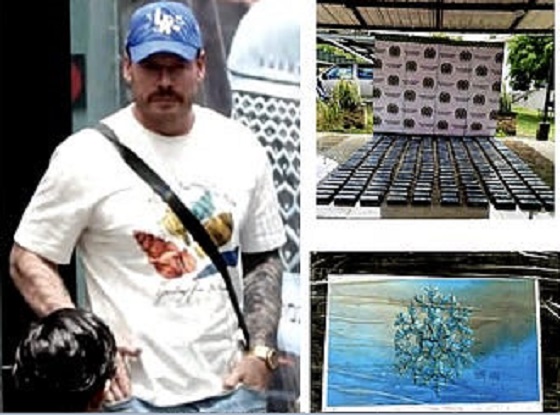Uncategorized
Saudi team after Post writer included soldiers, royal guards

ISTANBUL — Saudi royal guards, intelligence officers, soldiers and an autopsy expert were part of a 15-member team from the kingdom that targeted missing writer Jamal Khashoggi, Turkish media said Thursday. The Washington Post contributor vanished last week while visiting the Saudi Consulate in Istanbul.
The reported details, coupled with more-direct comments from Turkish President Recep Tayyip Erdogan, appear aimed at gradually pressuring Saudi Arabia to reveal what happened to Khashoggi, while also balancing Ankara’s need to maintain the kingdom’s investments in Turkey and relations on other issues.
In Washington, President Donald Trump expressed reservations over withholding American arm sales over the writer, even as prominent American lawmakers increasingly criticize Saudi Arabia — America’s longtime security ally in the region.
Turkish officials say they fear Saudi Arabia killed and dismembered Khashoggi, without offering evidence explaining why they believe that. Khashoggi contributed columns to the Post, including some critical of Crown Prince Mohammed bin Salman.
Saudi Arabia, before going silent in recent days, called the allegation it abducted or harmed Khashoggi “baseless.” However, it too has offered no evidence to support its claim the writer simply walked out of its consulate and vanished despite his fiancée waiting outside for him.
Information continues to trickle out through Turkish media about the 15-man Saudi team previously described as an “assassination squad.” These leaks, largely matching across Turkey’s state-run media and private Erdogan-linked outlets, likely come from the country’s security services as another means to pressure the kingdom over Khashoggi’s Oct. 2 disappearance.
The first plane of nine Saudis arrived from Riyadh around 3:30 a.m. that day, and included an individual described as a forensics official, according to the Sabah newspaper. One Turkish official, speaking on condition of anonymity to The Associated Press to discuss an ongoing police investigation, previously described that official as an “autopsy expert.”
The other six flew in on commercial flights, according to a list obtained by Sabah, which also published their names and faces. Local media described the Saudis being military and intelligence officers, as well as several “royal guards.”
Around the time Khashoggi entered the consulate, a second private plane from Riyadh took off for Istanbul. About two hours after he entered the consulate, video released by state media in Turkey shows several vehicles with diplomatic license plates, leave the consulate and drive some 2
The Hurriyet newspaper and other media alleged that the consulate’s 28 local staff were given the day off because a “diplomats’ meeting” would be held there. The reports did not cite a source and there was no official confirmation.
By 7 p.m., six of the Saudis left by the newly arrived private plane, flying onto Cairo and remaining overnight until heading back to Riyadh, according to Sabah and other media reports. By 11 p.m., another seven left by the other private plane, heading to Dubai, United Arab Emirates, similarly remaining there overnight and then flying on to Riyadh the next day, according to reports. Two others flew out commercially, Sabah said.
While the reports provide nothing definitive, they darken the picture surrounding Khashoggi’s disappearance.
Erdogan was quoted by Turkish media on Thursday as telling journalists flying with him back home from a visit to Hungary that “we cannot remain silent to such an incident.”
“How is it possible for a consulate, an embassy not to have security camera systems? Is it possible for the Saudi Arabian consulate where the incident occurred not to have camera systems?” Erdogan asked. “If a bird flew, if a mosquito appeared, these systems would catch them and (I believe) they (the Saudis) would have the most advanced of systems.”
Meanwhile, Trump told reporters in the Oval Office that he has a call in to Khashoggi’s fiancee, Hatice Cengiz, who has appealed to the president and first lady Melania Trump for help.
Trump said he had spoken with the Saudis about what he called a “bad situation,” but he did not disclose details of his conversations. He also said the U.S. was working “very closely” with Turkey, “and I think we’ll get to the bottom of it.”
White House press secretary Sarah Huckabee Sanders said national security adviser John Bolton and presidential senior adviser Jared Kushner spoke on Tuesday to Crown Prince Mohammed about Khashoggi.
Secretary of State Mike Pompeo then had a follow-up call with the crown prince to reiterate the U.S. request for information and a thorough, transparent investigation.
In an interview later Wednesday with “Fox News @ Night,” Trump said he wanted to find out what happened to Khashoggi but appeared reluctant to consider blocking arms sales, citing economic reasons.
“I think that would be hurting us,” Trump said. “We have jobs, we have a lot of things happening in this country. We have a country that’s doing probably better economically than it’s ever done before.”
“Part of that is what we’re doing with our
On his first international trip as president, Trump visited Saudi Arabia and announced $110 billion in proposed arms sales. The administration also relies on Saudi support for its Middle East agenda to counter Iranian influence, fight extremism and support an expected peace plan between Israel and the Palestinians.
Khashoggi had gone to the consulate on Tuesday last week to get paperwork he needed for his upcoming marriage. His Turkish fiancee waited outside.
The Post reported Wednesday evening that U.S. intelligence intercepts outlined a Saudi plan to detain Khashoggi. The Post, citing anonymous U.S. officials familiar with the intelligence, said Prince Mohammed ordered an operation to lure Khashoggi from his home in Virginia, where he lived most recently, to Saudi Arabia and then detain him.
___
Fraser reported from Ankara, Turkey, and Gambrell reported from Dubai, United Arab Emirates.
Ayse Wieting, Suzan Fraser And Jon Gambrell, The Associated Press
Uncategorized
Cost of bureaucracy balloons 80 per cent in 10 years: Public Accounts

The cost of the bureaucracy increased by $6 billion last year, according to newly released numbers in Public Accounts disclosures. The Canadian Taxpayers Federation is calling on Prime Minister Mark Carney to immediately shrink the bureaucracy.
“The Public Accounts show the cost of the federal bureaucracy is out of control,” said Franco Terrazzano, CTF Federal Director. “Tinkering around the edges won’t cut it, Carney needs to take urgent action to shrink the bloated federal bureaucracy.”
The federal bureaucracy cost taxpayers $71.4 billion in 2024-25, according to the Public Accounts. The cost of the federal bureaucracy increased by $6 billion, or more than nine per cent, over the last year.
The federal bureaucracy cost taxpayers $39.6 billion in 2015-16, according to the Public Accounts. That means the cost of the federal bureaucracy increased 80 per cent over the last 10 years. The government added 99,000 extra bureaucrats between 2015-16 and 2024-25.
Half of Canadians say federal services have gotten worse since 2016, despite the massive increase in the federal bureaucracy, according to a Leger poll.
Not only has the size of the bureaucracy increased, the cost of consultants, contractors and outsourcing has increased as well. The government spent $23.1 billion on “professional and special services” last year, according to the Public Accounts. That’s an 11 per cent increase over the previous year. The government’s spending on professional and special services more than doubled since 2015-16.
“Taxpayers should not be paying way more for in-house government bureaucrats and way more for outside help,” Terrazzano said. “Mere promises to find minor savings in the federal bureaucracy won’t fix Canada’s finances.
“Taxpayers need Carney to take urgent action and significantly cut the number of bureaucrats now.”
Table: Cost of bureaucracy and professional and special services, Public Accounts
| Year | Bureaucracy | Professional and special services |
|
$71,369,677,000 |
$23,145,218,000 |
|
|
$65,326,643,000 |
$20,771,477,000 |
|
|
$56,467,851,000 |
$18,591,373,000 |
|
|
$60,676,243,000 |
$17,511,078,000 |
|
|
$52,984,272,000 |
$14,720,455,000 |
|
|
$46,349,166,000 |
$13,334,341,000 |
|
|
$46,131,628,000 |
$12,940,395,000 |
|
|
$45,262,821,000 |
$12,950,619,000 |
|
|
$38,909,594,000 |
$11,910,257,000 |
|
|
$39,616,656,000 |
$11,082,974,000 |
Uncategorized
Trump Admin Establishing Council To Make Buildings Beautiful Again


From the Daily Caller News Foundation
By Jason Hopkins
The Trump administration is creating a first-of-its-kind task force aimed at ushering in a new “Golden Age” of beautiful infrastructure across the U.S.
The Department of Transportation (DOT) will announce the establishment of the Beautifying Transportation Infrastructure Council (BTIC) on Thursday, the Daily Caller News Foundation exclusively learned. The BTIC seeks to advise Transportation Secretary Sean Duffy on design and policy ideas for key infrastructure projects, including highways, bridges and transit hubs.
“What happened to our country’s proud tradition of building great, big, beautiful things?” Duffy said in a statement shared with the DCNF. “It’s time the design for America’s latest infrastructure projects reflects our nation’s strength, pride, and promise.”
“We’re engaging the best and brightest minds in architectural design and engineering to make beautiful structures that move you and bring about a new Golden Age of Transportation,” Duffy continued.
Mini scoop – here is the DOT’s rollout of its Beautifying Transportation Infrastructure Council, which will be tasked with making our buildings beautiful again. pic.twitter.com/
9iV2xSxdJM — Jason Hopkins (@jasonhopkinsdc) October 23, 2025
The DOT is encouraging nominations of the country’s best architects, urban planners, artists and others to serve on the council, according to the department. While ensuring that efficiency and safety remain a top priority, the BTIC will provide guidance on projects that “enhance” public areas and develop aesthetic performance metrics.
The new council aligns with an executive order signed by President Donald Trump in August 2025 regarding infrastructure. The “Making Federal Architecture Beautiful Again” order calls for federal public buildings in the country to “respect regional architectural heritage” and aims to prevent federal construction projects from using modernist and brutalist architecture styles, instead returning to a classical style.
“The Founders, in line with great societies before them, attached great importance to Federal civic architecture,” Trump’s order stated. “They wanted America’s public buildings to inspire the American people and encourage civic virtue.”
“President George Washington and Secretary of State Thomas Jefferson consciously modeled the most important buildings in Washington, D.C., on the classical architecture of ancient Athens and Rome,” the order continued. “Because of their proven ability to meet these requirements, classical and traditional architecture are preferred modes of architectural design.”
The DOT invested millions in major infrastructure projects since Trump’s return to the White House. Duffy announced in August a $43 million transformation initiative of the New York Penn Station in New York City and in September unveiledmajor progress in the rehabilitation and modernization of Washington Union Station in Washington, D.C.
The BTIC will comprise up to 11 members who will serve two-year terms, with the chance to be reappointed, according to the DOT. The task force will meet biannually. The deadline for nominations will end Nov. 21.
-

 Business16 hours ago
Business16 hours agoNew airline compensation rules could threaten regional travel and push up ticket prices
-

 Health2 days ago
Health2 days agoCDC’s Autism Reversal: Inside the Collapse of a 25‑Year Public Health Narrative
-

 Digital ID1 day ago
Digital ID1 day agoLeslyn Lewis urges fellow MPs to oppose Liberal push for mandatory digital IDs
-

 Crime2 days ago
Crime2 days agoCocaine, Manhunts, and Murder: Canadian Cartel Kingpin Prosecuted In US
-

 Daily Caller2 days ago
Daily Caller2 days agoBREAKING: Globalist Climate Conference Bursts Into Flames
-

 Health2 days ago
Health2 days agoBREAKING: CDC quietly rewrites its vaccine–autism guidance
-

 Great Reset1 day ago
Great Reset1 day agoEXCLUSIVE: The Nova Scotia RCMP Veterans’ Association IS TARGETING VETERANS with Euthanasia
-

 Energy2 days ago
Energy2 days agoHere’s what they don’t tell you about BC’s tanker ban










